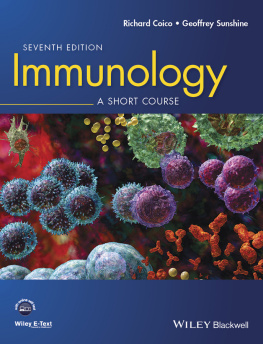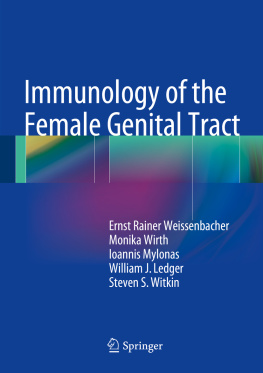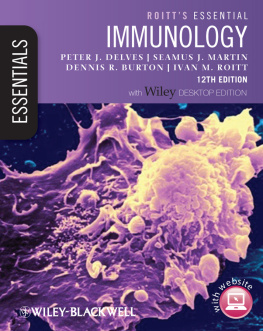Tak W. Mak
Mary E. Saunders
Bradley D. Jett
Wendy L. Tamminen
Maya R. Chaddah
Abbreviations
ACR acute cellular graft rejection
ADCC antibody-dependent cell-mediated cytotoxicity
AHR acute humoral graft rejection
AICD activation-induced cell death
AID activation-induced cytidine deaminase
AIDS acquired immunodeficiency syndrome
ALL acute lymphocytic leukemia
AML acute myeloid leukemia
APC antigen-presenting cell
2m beta2-microglobulin
BALT bronchi-associated lymphoid tissue
BCR B cell receptor
BMT bone marrow transplant
C constant; or complement component
CD cluster of differentiation
CDR complementarity-determining region
CGR chronic graft rejection
CHS contact hypersensitivity
CLL chronic lymphocytic leukemia
CLP common lymphoid progenitor
CLR C-type lectin receptor
CML chronic myelogenous leukemia
CMP common myeloid progenitor
CMV cytomegalovirus
CNS central nervous system
CR complement receptor
CSF colony-stimulating factor
cTEC cortical thymic epithelial cell
CTL cytotoxic T lymphocyte (effector)
D diversity
DAMP damage-associated molecular pattern
DC dendritic cell
DN double negative (CD4CD8)
DP double positive (CD4+CD8+)
DTH delayed type hypersensitivity
EBV EpsteinBarr virus
ER endoplasmic reticulum
FAE follicle-associated epithelium
FcR Fc receptor
FDC follicular dendritic cell
fTh follicular Th cells
GALT gut-associated lymphoid tissue
GC germinal center
GM-CSF granulocytemonocyte colony-stimulating factor
GvHD graft-versus-host disease
GvL graft-versus-leukemia effect
H heavy chain of Ig molecule; or hemagglutinin protein of influenza virus
HAR hyperacute rejection
HC hematopoietic cancer
HAV hepatitis A virus
HBV hepatitis B virus
HCV hepatitis C virus
HEV high endothelial venule
HIV human immunodeficiency virus
HL Hodgkins lymphoma
HLA human leukocyte antigen
HP hypersensitivity pneumonitis
HPV human papilloma virus
HS hypersensitivity
HSC hematopoietic stem cell
HSCT hematopoietic stem cell transplant
HSP heat shock protein
HSV herpes simplex virus
IBD inflammatory bowel disease
IC immune complex
ICAM intercellular adhesion molecule
IFN interferon
Ig immunoglobulin
Ii invariant chain
IL interleukin
iNOS inducible nitric oxide synthase
ITAM immunoreceptor tyrosine-based activation motif
ITIM immunoreceptor tyrosine-based inhibition motif
iTreg induced regulatory T cell
IV-IG intravenous immunoglobulin replacement therapy
J joining
KIR killer Ig-like receptor
L ligand; or light chain of Ig molecule
LC Langerhans cell
LPS lipopolysaccharide
LT lymphotoxin
mAb monoclonal antibody
MAC membrane attack complex
MAdCAM mucosal addressin cellular adhesion molecule
MALT mucosa-associated lymphoid tissue
MAMP microbiota-associated molecular pattern
MBL mannose-binding lectin
MBP myelin basic protein
MCP mast cell progenitor
MHC major histocompatibility complex
mIg membrane-bound Ig
MiHA minor histocompatibility antigen
MIIC MHC class II compartment
miRNA microRNA
MPP multipotent progenitor
MS multiple sclerosis
mTEC medullary thymic epithelial cell
N neuraminidase protein of influenza virus
NALT nasopharynx-associated lymphoid tissue
NCR natural cytotoxicity receptor
NET neutrophil extracellular trap
NHC non-hematopoietic cancer
NHEJ non-homologous end joining pathway of DNA repair
NHL non-Hodgkin's lymphoma
NK natural killer cell
NKT natural killer T cell
NLR NOD-like receptor
nTreg natural regulatory T cell
PALS periarteriolar lymphoid sheath
PAMP pathogen-associated molecular pattern
PCR polymerase chain reaction
PD-1 programmed death-1
pDC plasmacytoid dendritic cell
pIgR poly-Ig receptor
pMHC peptideMHC complex
PMN polymorphonuclear leukocytes
PRM pattern recognition molecule
PRR pattern recognition receptor
pT pre-T alpha chain
PTK protein tyrosine kinase
RA rheumatoid arthritis
RAG recombination activation gene
RBC red blood cell
RCA regulator of complement activation
RLR retinoic acid inducible gene-1-like receptor
RNI reactive nitrogen intermediate
ROI reactive oxygen intermediate
RSS recombination signal sequence
S switch region
SALT skin-associated lymphoid tissue
SCF stem cell factor
SCID severe combined immunodeficiency
sIg secreted Ig
SIg secretory Ig
SLC surrogate light chain
SLE systemic lupus erythematosus
SMAC supermolecular activation cluster
SNP single nucleotide polymorphism
SP single positive (CD4+ or CD8+)
T1DM type 1 diabetes mellitus
TAA tumor-associated antigen
TAP transporter associated with antigen processing
TB tuberculosis
Tc cytotoxic T cell (nave)
Tcm central memory T cell
TCR T cell receptor
Td T-dependent
TdT terminal dideoxy transferase
TDTH T cell mediating delayed type hypersensitivity
TEC thymic epithelial cell
Tem effector memory T cell
TGF transforming growth factor beta
Th helper T cell
Ti T-independent
TIL tumor-infiltrating lymphocyte
TLR Toll-like receptor
TNFR tumor necrosis factor receptor
TSA tumor-specific antigen
TSG tumor suppressor gene
TSLP thymic stromal lymphopoietin
V variable
VAERS Vaccine Adverse Events Reporting System
VCAM vascular cellular adhesion molecule
VEGF vascular endothelial growth factor
VZV varicella zoster virus
WHO World Health Organization
WT wild type
XP xeroderma pigmentosum
Cover Image
The cover image portrays a myeloid-derived suppressor cell (MDSC; light-blue cell with short protrusions) as it differentiates into tumor-associated macrophages. Depending on the microenvironment surrounding the tumor (clumps of reddish-brown cells), MDSCs are thought to give rise to either M1 macrophages (dark-brown spherical cells with long protrusions) or M2 macrophages (light-blue spherical cells with long protrusions in the background). M1 macrophages have tumoricidal activities, whereas M2 macrophages promote tumor growth. This image, rendered by Cheng-Jung Lai, was taken from a 2011 article titled Paired Immunoglobulin-like Receptor-B Regulates the Suppressive Function and Fate of Myeloid-Derived Suppressor Cells, by Ma, G., Pan, P., Eisenstein, S., Divino, C., Lowell, C., Takai, T., and Chen, S. (Immunity 34: 385395). This article is featured in the Focus on Relevant Research box in ).
Copyright
AP Cell is an imprint of Elsevier
30 Corporate Drive, Suite 400, Burlington, MA 01803, USA
525 B Street, Suite 1900, San Diego, California 92101-4495, USA
84 Theobald's Road, London WC1X 8RR, UK
This book is printed on acid-free paper.
Copyright 2014 Elsevier Inc. All rights reserved.
No part of this publication may be reproduced or transmitted in any form or by any means, electronic or mechanical, including photocopy, recording, or any information storage and retrieval system, without permission in writing from the publisher.







